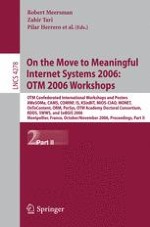2006 | Book
On the Move to Meaningful Internet Systems 2006: OTM 2006 Workshops
OTM Confederated International Workshops and Posters, AWeSOMe, CAMS, COMINF, IS, KSinBIT, MIOS-CIAO, MONET, OnToContent, ORM, PerSys, OTM Academy Doctoral Consortium, RDDS, SWWS, and SeBGIS 2006, Montpellier, France, October 29 - November 3, 2006. Proceedings, Part II
Editors: Robert Meersman, Zahir Tari, Pilar Herrero
Publisher: Springer Berlin Heidelberg
Book Series : Lecture Notes in Computer Science
